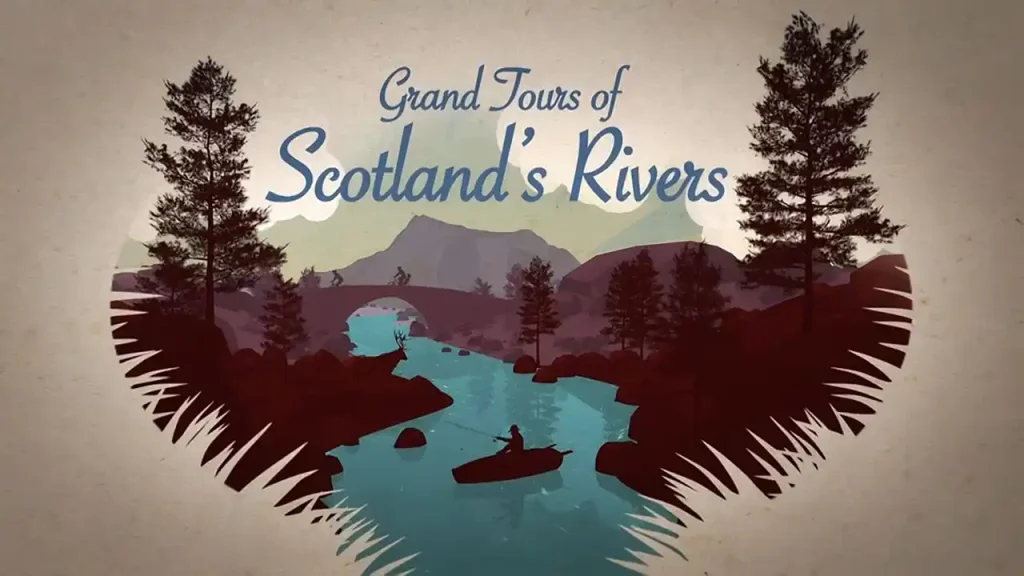Grand Tours of Scotland’s Rivers episode 4 – North Esk – Nestled in the enchanting landscapes south of Edinburgh, the North Esk River emerges as a hidden jewel, its waters reflecting the captivating tales and history that define the region. Our adventurous traveler, Paul, sets out to trace its winding course, starting from the commanding Pentland Hills and navigating through a terrain that is richly imbued with myth and legend. The journey unfolds at Habbie’s Howe, a spot where picturesque beauty marries delight in its purest form. Enveloped in tranquility and natural charm, this enchanting location serves as a serene backdrop to Paul’s adventure. Each rustling leaf and whispering wind seems to carry a tale from the past, adding a layer of mystique to his exploration.
From the peaceful serenity of Habbie’s Howe, Paul proceeds to Roslin Glen, a site steeped in inspirational charm. Over the centuries, this remarkable location has served as a wellspring of creativity, sparking the imagination of countless artists and writers. Its bewitching allure and natural beauty have shaped some of the greatest creative works, testament to its indelible impact on the world of arts and literature. Perched high above on the towering cliffs lies the enigmatic Rosslyn Chapel. Its architecture cloaked in mystery and intrigue, the chapel’s austere presence adds a profound depth to the scenic landscape of Roslin Glen. This historic monument has stood the test of time, silently watching over the unfolding stories beneath its solemn gaze.
The North Esk River is not just a natural wonder but also a testament to the region’s industrial past. In a fascinating interplay of nature and innovation, the river’s powerful current was harnessed to drive the wheels of progress. The once-thriving papermaking industry drew its lifeblood from these waters, leaving a lasting imprint on the region’s industrial landscape. In his quest to uncover the river’s historical imprint, Paul stumbles upon remnants of this industrial legacy. Rustic structures and abandoned factories offer silent yet eloquent narratives of a time when the rhythm of the river resonated with the hum of machinery.
His journey culminates in the ancient coastal town of Musselburgh, a settlement of considerable antiquity near the bustling city of Edinburgh. As he explores its timeworn streets, he is reminded of the long-forgotten tales that the town has to offer.
Paul’s expedition along the North Esk River is a sensory voyage through time, revealing the multifaceted layers of the region’s cultural, artistic, and industrial history. It is a testament to the inextricable bond between humanity and nature, an ode to the timeless tales that reside in the heart of Scotland’s hidden gem.
Grand Tours of Scotland’s Rivers episode 4 – North Esk
North Esk in Scotland
The North Esk is a river in Scotland that flows through the counties of Angus and Aberdeenshire. It is one of the two main tributaries of the River Esk, which empties into the North Sea at Montrose. The North Esk has a length of about 80 km and a catchment area of 586 km2. It rises in the Grampian Mountains and passes through several towns and villages, such as Tarfside, Edzell, Stracathro and Marykirk.
History and Culture
The North Esk has a rich history and culture, dating back to the prehistoric times. The river valley has been inhabited by various peoples, such as the Picts, the Romans, the Scots and the Anglo-Saxons. The river was also a site of several battles and skirmishes, such as the Battle of Nechtansmere in 685 AD, the Battle of Stracathro in 1130 AD and the Battle of North Esk in 1645 AD. The river also played a role in the Jacobite rebellions of the 18th century, as it was crossed by the armies of both sides.
The North Esk has also inspired many artists and writers, such as Sir Walter Scott, Robert Burns, James Hogg and Lewis Grassic Gibbon. The river features in several poems, novels and songs, such as Scott’s The Antiquary, Burns’ The Banks o’ Doon, Hogg’s The Queen’s Wake and Gibbon’s Sunset Song. The river is also celebrated in local folklore and traditions, such as the annual Riding of the Marches in Edzell.
Wildlife and Environment
The North Esk is home to a diverse wildlife and environment, ranging from the mountainous uplands to the coastal lowlands. The river supports a variety of fish species, such as salmon, trout, eels and lampreys. The river also attracts many birds, such as herons, kingfishers, dippers and ospreys. The river banks are lined with woodlands, grasslands and wetlands, which provide habitats for mammals, reptiles, amphibians and insects. Some of the notable species include otters, badgers, roe deer, red squirrels, adders, frogs and butterflies.
The North Esk is also part of several nature reserves and conservation areas, such as the Glen Esk National Scenic Area, the Montrose Basin Wildlife Reserve and the River South Esk Special Area of Conservation. These areas aim to protect and enhance the natural beauty and biodiversity of the river and its surroundings. The river also offers many opportunities for recreation and tourism, such as fishing, walking, cycling, canoeing and wildlife watching.
Conclusion
The North Esk is a river that flows through Scotland with a long and rich history and culture. It has inspired many artists and writers over the centuries and has been a site of many historical events. It is also a river that hosts a diverse wildlife and environment, from the mountains to the sea. It is part of several nature reserves and conservation areas that aim to preserve its natural heritage. It is also a river that offers many activities for recreation and tourism for locals and visitors alike.
